
Transmitting news and information about sustainable endeavors in Coastal Virginia and beyond. Updated Weekly.
The atmosphere and oceans contain more carbon now than at any other time in human history while the soil, a carbon storehouse, is being robbed of the building block of life. Overuse and depletion of fossil, vegetative, and land resources has created a global carbon imbalance. Transforming to a clean energy economy will help resolve the condition, but to cure it, carbon must be captured, recycled and stored. By engineering high tech as well as down to earth strategies, entrepreneurs aim to cash in on the carbon conundrum. A host of pioneering carbon offsetting initiatives are discussed including carbon trading, regenerative agriculture and biomass fixing, as well as drawing down ambient CO2 as a feedstock for products including fuel. |
The Climate Cure:
Balancing Earth's Carbon Equilibrium by Transforming a Liability into a Commodity
Posted 5 October 2015 by Carol Brighton
2015 is likely to remembered as a pivotal point in history. Given the foreboding consequences of procrastination on the global warming front, prominent figures from the religious, political and business world are joined by those in the medical and entertainment industry in a quest for climate action. In September, the Pope for the first time ever addressed the US Congress. This occurred as UN representatives and international business leaders convened in NYC at two separate but also significant events. A key issue on every agenda was climate. During UN meetings, delegates from 193 countries committed to 17 sustainable goals including climate action. Meanwhile representatives from the corporate world met to network and discuss strategies to reduce their carbon footprint and to garner support for upcoming international treaty talks in Paris later this Fall. Momentum is clearly in their court as China just outlined plans solidifying a joint commitment with the United States to reduce CO2 emissions. Previous precedent also indicates that consensus can be reached on a climate accord. The world successfully responded to a similar crisis in the past. The 1987 Montreal Protocol led to the phase out of ubiquitous ozone destroying chemicals responsible for stratospheric holes above the poles. Whether talks in Paris are fruitful, savvy business planners are taking the matter into their own hands and stepping up to address the climate challenge.
|
Corporate Analysis
With climatic disruptions attributable to global warming already occurring and predictions of more prevalent and pervasive impacts looming on the horizon, corporate revenues are threatened. The Risky Business Project recently quantified the domestic economic threat. Analysis by the group measures the costs of inaction nationally by region. According to Michael Bloomberg, “Our report shows that the longer we wait to adapt to and mitigate climate change, the more devastating the economic impacts will be. …We cannot afford to wait another minute because climate change is costing local governments and businesses billions of dollars.” With their bottom lines at risk, it is becoming clearly evident to the movers and shakers of the world that business as usual is no longer an option. To protect their assets, corporate leaders are coming out of the closet in droves to support action. Counted among iconic company heads leading the charge are Richard Branson, Bill Gates, and Ben and Jerry. Businesses are already strategically accounting for climate change by putting a price on carbon. Thousands have pledged to support climate action and some have already taken unilateral action, implementing measures to reduce and negate carbon emissions. While there is an expense involved in making these changes, the cost of inaction is even greater.
Creating Opportunity by Offsetting Carbon Emissions
Clean energy will no doubt play a vital role in reversing our current climate course. The industry is booming and a number of companies have committed to make a complete power shift to renewables. But, even as emissions are eliminated, to avoid the inertia of continued warming caused by past discharges, the carbon balance needs to be restored. While acting as good global citizens and responding to the climate issue, its possible for business to turn a climate liability into financial opportunity. Discussed below are several enabling programs and strategies to restore the carbon balance.
Achieving Carbon Neutrality & The Carbon Market
Companies that implement sustainibility initiatives stand to gain financially by limiting future expenses and loses while improving their brand image. In a New York Times op-ed, Joe Kaeser, chief executive of Siemens explains another route to limit climate impacts. Siemens global operations will be carbon neutral by 2030. He writes, "We will accomplish this by eliminating a vast majority of our carbon emissions, while also supporting projects that reduce greenhouse gas emissions outside of Siemens, known as carbon offsets. Our net CO2 emissions will be zero. This plan requires a substantial investment, it will pay off quickly. In fact, we expect our $110 million investment to pay for itself in just five years and generate $20 million in annual savings thereafter."
|
Demand for carbon offsets has created a relatively new financial sector. In the United States, the carbon market is mostly voluntary, but regional emission alliances are at work on the West Coast and the North East. There is also a well established, though somewhat flawed, system in Europe. Despite some concerns, the markets could provide a valuable vehicle for conservation and restoration projects (discussed more below). While still small, the carbon trading marketplace is likely to grow as states move to implement the EPA's clean power plan. A listing of companies that trade both compliance and voluntary offset at the retail, wholesale and brokerage level can be found on the Climate Action Reserve (CAR) website. CAR is one of several third party verifiers of offset programs. Organizations like CAR, the Gold Standard and Verified Carbon Standard validate and monitor progress at project sites. Offsets have been available to individual consumers through a few outlets like Terapass. The United Nations just announced the launch of a new platform for individuals. Climate Neutral Now allows users to calculate their carbon footprint and then purchase offsets for specifically chosen projects. Offsetting projects are located in developing countries that often cannot afford to reduce emissions on their own.
Carbon Capture & Storage
In a world economy dominated by fossil fuels, there will be difficulties weaning off the carbon intensive resource. So, it should come as no surprise that governments and industry are investing in strategies for on site carbon capture and storage (CCS) technology. The money being poured into the technology is staggering. According to the Financial Times, the world has spent $24 billion over the last 14 years to develop CSS. In the US, the DOE just awarded 8 companies $25 million to develop CSS systems. Worldwide, the IEA reports that there are now 13 industrial CSS plants with 24 more in advanced stages of planning/development. One commercial facility is operating in Saskatchewan, Canada. If universally accepted, CSS will allow fossil plants to continue to operate, but at best it will only limit the growth of atmospheric concentrations of carbon. The costs associated with on site capture range between $90 and $150 per ton of CO2, whereas potentially more effective land management strategies cost about one quarter of that.
Cultivating Carbon Away
A very simple solution to skyrocketing carbon levels could be right beneath our feet in the land. As agricultural productivity is threatened by climate change, it turns out modern farming practices are contributing to the problem. Thanks to industrial farming methods, a lot of carbon has been displaced. A 2013 UN publication reports that “25 to 40 per cent of the current excess of CO2 in the atmosphere results from the destruction of soils and their organic matter.” So it seems that soil health influences climate in a rather significant way. Aside from switching to clean energy, adopting “regenerative” food production methods can have a vast impact on the carbon balance. Soils rank second only to the ocean in carbon storage capacity. Better land management will not only prevent carbon loss to the atmosphere and sea, it may be one of the most effective ways to capture and store ambient carbon. As Larry Kopald of the Carbon Underground explains, "Nature has dealt with much worse levels of carbon in the atmosphere before our time. It’s exactly what photosynthesis was designed to do. But unhealthy soil has now been shown to shut down this process-- trapping the carbon in the air and disrupting the climate.”
Polyfaces Trailer from RegrariansMedia on Vimeo. Read Joel Salatin's article posted In These Times. See Also Polyfaces- Early in the Morning. Watch these short film productions to learn more about regenerative agriculture and carbon farming: Soil Carbon Cowboys, the Soil Story introduced by Virginia native Jason Mraz, PBS Video SOS: Save Our Soil, and Soil Carbon Curious - an NRDC production on White Oak Pastures a zero waste farm. |
Regenerative Agriculture at Polyface Farm in Virginia
By rebuilding soils through sustainable farming practices, carbon balance can be restored. The rise of the organic food business is already supporting this trend. With growing demand for organic produce and meat, there’s a groundswell of support for sustainable food production and regenerative agriculture. One proponent of carbon farming is Joel Salatin of Swoope, Virginia. Salatin practices a holistic method of farming which promotes the growth of bacteria, fungi, earth worm and organic matter deep in the ground. Featured in Michael Pollan’s best selling book, the Omnivore’s Dilemma, the farmer was catapulted into celebrity status on the sustainable food scene. He's since published a book of his own and is regularly invited to speak internationally. A forthcoming documentary features the regenerative agriculture practiced at his Shenandoah Valley farm. In particular, at Polyface, polyculture is practiced and livestock grazing is at the heart of the restorative process. As Salatin puts it, "There is no ecosystem that functions without animals. ...On our farm, we're using high-tech electric fencing to biomimic the great migratory patters of herbivores throughout nature." He calls this alternating paddocking method "mob-stocking-herbivorous-solar-conversion lignified-carbon-sequestration-fertilization." And according to Salatin it has transformed his farm: "We’ve gone from 1 percent organic matter to 8 percent in 50 years. All we have to do nationwide is go from 1 percent to 2 percent and we would mitigate all the carbon that has been emitted since the beginning of the industrial age" in fewer than 10 years.
Salatin's support for regenerative agriculture is shared among many in the organic community. This summer an international team launched an initiative to promote the practice in order to safely feed the world and fight climate change. Andre Leu, a participant in the Regeneration International Working Group co-authored a United Nations study on Soil Health and Climate Change and reports that, "This is a game changer. ... We have numerous published, peer-reviewed scientific papers showing that with the right agricultural techniques we can strip enough CO2 out of the atmosphere to reverse climate change." Ronnie Cummins, another member of the group and international director of the Organic Consumers Association commented that, “This is new science that’s connecting the food issues with the climate issue, making it more and more clear that by fixing the soil, and fixing the way we produce food, we can fix the climate as well.” An Ohio State University Extension Fact Sheet states, "Once sequestered, carbon remains in the soil as long as restorative land use, continuous no-till, and other Best Management Practices are followed. It is a win-win option. While mitigating climate change by off-setting fossil fuel emissions, it also improves quality of soil and water resources, enhances agronomic productivity, and buys us time to identify and implement viable alternatives to fossil fuel."
|
In California, Gov. Jerry Brown launched what he called the "Healthy Soils Initiative" to support farmers building up carbon in their soils. Without funding, the program exists in name only. On a larger level, its possible that soil health strategies will be considered during international talks starting in Paris in November. The UN already declared 2015 the year of Soil. Whether the international community acts or not, consumers can make a difference. In her book Organic Manifesto, Maria Rodale points out: "If you do just one thing--make one conscious choice--that can change the world, go organic. Buy organic food. Stop using chemicals and start supporting organic farmers. No other single choice you can make to improve the health of your family and the planet will have greater positive repercussions for our future."
Farming at Sea
Farming practices to sequester carbon aren't limited to land. Seaweed aquaculture represents a sustainable opportunity to produce highly nutritious sustenance around the world's major population centers without the need any additional inputs. In addition to taking in carbon, seaweed farms improve water quality by reducing nuisance nutrients and acidity in the water column while increasing oxygen levels. A project to study the potential of seaweed farming is being conducted by NOAA, the Pugent Sound Fund and other partners. Dr. Michael Rust, NOAA Aquaculture Science Coordinator and a collaborator on the project notes that,"There are not a lot of tools in the tool box that can fight ocean acidification or remove carbon dioxide (CO2) from the ocean. Seaweed farms might be one of our best bets....When the seaweed is harvested it takes the excess carbon and nitrogen with it, effectively removing them from the ocean." Salad from that sea may not seem that appetizing to some, but a new strain of seaweed cultivated at Oregon State tastes like bacon when fried. Chris Langdon of the Hatfield Marine Science Center in Newport Oregon has been growing and studying dulse seaweed for decades and is now working with the Food Innovation Center in Portland on creating healthy and appealing dishes. Learn more about the potential of seaweed in previous posts here and here.
Developing Carbon Assets: Biomass Storage & Carbon Pricing
Through human development, natural sinks of carbon continue to be destroyed daily. Deforestation continues to occur at unsustainable levels. The University of Maryland and Google reported on Global Forest Watch that 45 million acres of trees were lost in 2014. Blue carbon stored in the marine environment is likewise being released as development and pollution diminish these habitats. Though relatively small in geographic coverage, coastal ecosystems like mangroves, salt marshes and seagrasses sequester carbon at rates ten times higher than most forested systems. Improving biomass capacity both on land in and in the sea will counter a warming trend while also providing a multitude of ancillary benefits.
|
As noted above, the carbon market is still young. Given the difficulty of quantifying sequestration rates of natural systems, offset opportunities are limited. As the industry grows in the coming regulatory market, carbon offsets could prove to be a real game changer in the field of conservation and restoration. Restoration methodologies are being approved for carbon offset transactions by validation organizations. Building highly productive ecosystems, will not only offset carbon emissions it will increase coastal resilience through storm protection and provide habitat for commercially sought species and clean water and air.
Restoring Coastal Blue Carbon
Tierra Resources of Louisiana developed an innovative methodology to transact carbon offset credits through wetland restoration. Certified by the American Carbon Registry for the Mississippi Delta, the group just completed a three year pilot project restoring 3 acres of wetlands. In doing so, the company championed a new strategy that successfully established mangroves within a fraction of time and cost of traditional planting methods. By air seeding from a a crop duster, planting costs were reduced 97%. According to company president Dr. Sarah Mack, “Our carbon finance methodology paired with techniques like mangrove air seeding provide the opportunity to expedite wetland restoration at a scale and a cost that hasn’t been done before." Using this strategy, the organization aims to restore over 30,000 acres of coastal Louisiana over the next 10 years. Entergy announced that they will join forces with Tierra Resources in 2016 to further demonstrate the scalability and affordability of mangrove air seeding.
|
Like the Gulf Coast, wetland restoration is essential in and around the Chesapeake Bay. To stabilize shoreline erosion at the Chesapeake Bay Environmental Center in Grasonville Maryland, a planting system new to the region was deployed. The Bay-Saver bag technology devised by Restore the Earth Foundation is designed for quick installation and fast growth. The initiative is part of a pilot carbon offset project managed by the Society of Environmental Toxicology and Chemistry (SETAC) and partners. The EKO Bag® concept consists of a biodegradable casing that contains custom mixed soil with composted humus amendments. The materials support, feed, and stabilize the native cordgrass. Data provided by Restore the Earth Gulf Coast projects indicate that cost of planting are reduced by more than half compared to bare root plugs while survivability is increased by about 50%. In addition, revegetation of the project area progressed 5 times faster than plug plantings.
Restore America's Estuaries is involved in wetland sequestration research. The national non-profit is leading a team of organizations at work in Tampa Bay. The group has been investigating storage rates in mangroves, marshes and seagrass beds and has submitted a carbon offset methodology for blue carbon offset verification that could soon garner financial support for continued stewardship efforts in the area. Seagrasses play a very important role in Tampa Bay. Not only to the underwater grasses remove more carbon than previously thought, they may also reduce acidity. It appears that the recovery of seagrass beds supported by 3 decades of replenishment may be responsible for lower acidity levels in the Bay. While acidity levels in the global ocean increased 30%, they have dropped in Tampa Bay. The high rates of carbon fixation could be unique to Tampa Bay. Researchers believe the grasses are chemically fixing CO2 through a bicarbonate pathway caused by a reaction between oxygen and carbonate. It is this reaction that may also be responsible for reduced acidity levels. See more about this process.
Reforestation
A more developed marketplace for forest carbon offsets exists. Projects can protect a standing site from conversion or reestablish forest. A number of companies participate in the forestry marketplace. Green Trees headquartered in The Plains,Virginia is a major player monetizing the carbon storage in forests. The company boasts $2 million in carbon credits sold with close to 100,000 acres of reforestation projects. Investors include Norfolk Southern and Duke Energy. Norfolk Southern sponsors the Trees and Trains Initiative along with the Longleaf Alliance and the American Chestnut Foundation and the Nature Conservancy. The carbon markets provide the opportunity for Norfolk Southern to recoup some of their investment. For a South Carolina Long Leaf Pine project organized by Finite Carbon, the railroad earned 300,000 carbon-offset credits from the Climate Action Reserve. With a long life span, Norfolk Southern has agreed to maintain the Brosnan Long Leaf Pine Forest for 100 years. According to Josh Raglin general Manager of the Brosnan Forest. "It's cleaning the air and doing something good for the environment. At the same time, we get a credit through a market-based fee system, so it's contributing to the company's bottom line." On this one project, the company expects a $3 million return on investment.
|
Reforestation by Drones
Reforestation efforts in remote locations can be slow, expensive and labor intensive. BioCarbon Engineering plans to speed up the process dramatically by employing drones. The plan is to use a fleet of autonomous vehicles to plant a billion trees. The project was the €100,000 grand prize winner in the Hello Tomorrow Challenge. Armed with sensors, unmanned aerial vehicles (UAVs) will conduct mapping and surveying analysis of what is often challenging and inaccessible terrain. With data on the area to be restored, a landscape plan can be developed which will also be carried out by the UAVs. Seed pods made from biodegradable material and containing a germinated tree seedling set in a nutrient rich gel will be delivered with precision to the site. The pods will be propelled with force so they break open when lodged into the ground. The UAVs will also be used to monitor reforested sites for assessment purposes. Unmanned vehicles could also prove to be very cost effective for coastal initiatives as well.
|
Building Carbon Stores
The building industry alone is responsible for almost half of CO2 emissions. By creating structures with carbon neutral or negative materials and designing for energy neutral or positive operation, it may be possible to build our way out of the carbon conundrum. Next to water, concrete is the most consumed substance on earth. A key component of concrete, cement contributes 5 to 8% of all CO2 emitted. Annually over 2 billion tons of cement are used worldwide which results in the emissions of over 2 billion tons of the greenhouse gas.
Hempcrete & Natural Building Materials
Natural building materials like hemp, straw and wood, utilize carbon during photosynthesis. When incorporated into structures, that carbon is stored. Hempcrete, a concrete like material more frequently used in Europe actually continues to absorb CO2 throughout its life. In the United States, a few structures including one in Virginia Beach have been constructed with the material. Slow growth on this side of the Atlantic results from federal regulations that prohibit industrial hemp production. But with a groundswell of support for this versatile and eco friendly crop, many states are now allowing research farming. In the not too distant future, there is real potential for widespread domestic adoption of CO2 consuming hempcrete.
Carbon Neutral & Negative Concrete
Hempcrete can replace concrete in some construction, particularly the residential sector, but for many commercial applications, concrete will continue to dominate. Cement is an essential element in concrete. To produce one ton of portland cement, one ton of carbon is emitted. By reformulating the production process, some cement companies are reducing their carbon footprint. A couple claim to have a carbon negative product. California company, Calera, is using smokestack carbon to make a calcium carbonate cement by mimicking the reef building processes. It is being used to make decorative and board products and as a partial replacement for Portland cement in sidewalk and commercial concrete construction. Brent Constanz, the Stanford professor behind Calera recently founded Blue Planet. The company is taking the product to the next level. They are producing carbon negative concrete by also making their own aggregate. In addition, reflective roofing granules and pigments are also listed among products available. But is appears that for now, their products are only available for limited use in the California market. Several other companies are producing carbon neutral cement. CeraTech of Alexandria, VA's ekkomax product has been validated under Environmental Product Declarations and meets the standards for LEED and the 2030 challenge accreditation. Production of ekkomax reduces CO2 emissions and water use while diverting fly ash from landfills. The durable material is certified for all types of uses and is available all over the country. More information about carbon neutral and negative cements can be found a report prepared for the D.C. Department of the Environment: Analyze on Carbon Negative Cement.
Growing Bricks & Rock
Bricks represent another ubiquitous building material that emit a significant source of carbon during manufacture. Over a trillion bricks are produced every year. A North Carolina company has created a biocement brick that cures under ambient temperatures. No firing required. Instead, BioMason uses bacteria to produce its carbon neutral bricks. Made on site with locally sourced materials including sand, water, and calcium, a mix is poured in molds and through a chemical process, grows hardened bricks. In August, the company was selected as one of 15 semi-finalist out of a pool of 400 for the 2015 Buckminster Fuller Challenge. Every year the Buckminster Fuller Institute awards a $100,000 prize to support an innovative solution to some of the world's more challenging problems. The winner of this year's purse will be announced in November.
A UK based architecture firm is planning to engineer a shell shaped pavilion underwater using biorock technology. Mimicking the reef building process, architects at Exploration intend to immerse a steel frame in sea water charged with a small current to stimulate mineralization. The process has been demonstrated in Indonesia in a number of biorock reef restoration projects. Designers believe that with slow deposition, the material will be stronger than concrete. Watch Designing with Nature: The Biorock Pavilion
|
Capturing Carbon & Using CO2 as Feedstock
In addition to building materials, carbon can be captured and used for a variety of purposes. Chemicals, paints, plastics, carbon fiber and even fuels can be manufactured from captured carbon. Technologies are being developed to remove and reuse carbon at stationary emission sources and from the ambient environment.
Diverting the gas from smokestacks to feed commercial greenhouses and to fuel algae production represents a promising arena of opportunity. The gas stimulates photosynthesis and increases plant growth and crop yields. Algae are fast growing and particularly efficient at digesting carbon. It is also an amazingly versatile ingredient used for food additives, cosmetics, fish and animal feed and fuel. Several companies like Joule and Algenol are looking to produce algae for fuels among other things. HyTek Bio out of Baltimore is focusing on scrubbing power plant emissions and creating a revenue source from more than one waste stream. The company evolving out of the UMD, is growing a strain of algae from the Chesapeake Bay. An experimental bioreactor is being fed by the carbon emitting methane power generation facility at the Black River waste water treatment plant. To fertilize the algae, the company has also developed a process to glean nutrients from chicken manure that might otherwise flow into the Bay. The algae powder product is high in sought after nutritional supplements and can be sold for $40 per pound.
|
Pulling Carbon Out of the Ambient Environment
To avert certain climate consequences, excess CO2 needs to be drawn down sooner rather than later. New technology being developed could help resolve the problem without the longer term and expansive space requirement of forest and wetland projects. Several pilot plants are pulling CO2 out of the air and seawater. US based Global Thermostat, Canada's Carbon Engineering backed by Bill Gates, and Climeworks of Switzerland have demonstration plants filtering CO2 out of the atmosphere. Facilities large enough to cycle millions of tons of CO2 could be sited near emission sources, like industrial areas and highways, on relatively small parcels. Among other things, CO2 captured can be recycled to produce carbon neutral fuels. In partnership with Sunfire, Audi tested a synthetic diesel made this year from Climeworks feedstock and that captured at a biogas plant. The company has been producing CNG using wind energy and waste CO2 for 2 years.
With much denser concentrations of CO2 in seawater than in the atmosphere, the Naval Research Lab is removing CO2 from the ocean to produce a drop-in replacement fuel. Fuel produced from the seawater extraction process was used to power an internal combustion engine in a model aircraft at Bloossom Point, MD. At scale, the cost of producing fuel from seawater is projected to cost $3 to $6 per gallon. The Navy has hundreds of ships, thousands of aircraft and many thousands of small craft all based along coastlines and deployed throughout the world's oceans. A domestically sourced, consistently priced, and carbon neural fuel replacement that can be produced on site at remote locations supports national security and would provide numerous tactical advantages to the Naval fleet. Watch this NRL video. Learn more here.
The possibilities for capturing and reusing carbon are endless and research is steaming ahead at full speed. The Center for Negative Carbon Emissions at Arizona State is spearheading research. They're testing a resin which can absorb carbon from the atmosphere and release it within a greenhouse environment. At George Washington University researchers have developed a process to manufacture nanofibers while scientists at the University of Colorado Boulder have engineered a waste water treatment system that consumes CO2 in the process and produces energy. Learn more about these projects and follow new developments on Pinterest.
Related Posts:
Nature at Work: Building Ecological Infrastructure
Is the U.S. Ecologically Overdrawn?
Adapting to Rising Seas with Aquatecture
Alternative Power Prospects Brighten in Virginia
Check the Archive for Previous Posts
All Rights Reserved. Disclaimer.


 The world's corporate giants are responding to the climate crisis. Represented above are just some of the organizations that have pledged to go 100% renewable. See more at
The world's corporate giants are responding to the climate crisis. Represented above are just some of the organizations that have pledged to go 100% renewable. See more at 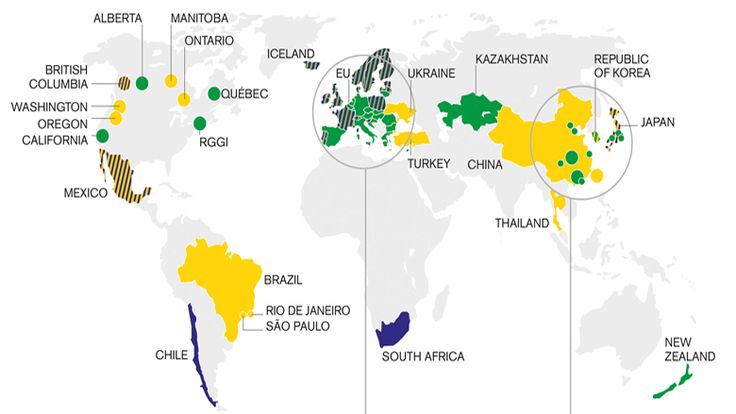 Carbon Markets - 40 national and 23 city, states and regions are putting a price on carbon. From "
Carbon Markets - 40 national and 23 city, states and regions are putting a price on carbon. From " A Seaweed that tastes like bacon has been developed by researchers at OSU. Dulse Seaweed - Image:
A Seaweed that tastes like bacon has been developed by researchers at OSU. Dulse Seaweed - Image:  In partnership with ConocoPhilips, Tierra Resources distributed mangrove seeds by crop duster to remote Louisiana locations within a fraction of the time and cost of associated conventional planting methods. Image: ConocoPhilips
In partnership with ConocoPhilips, Tierra Resources distributed mangrove seeds by crop duster to remote Louisiana locations within a fraction of the time and cost of associated conventional planting methods. Image: ConocoPhilips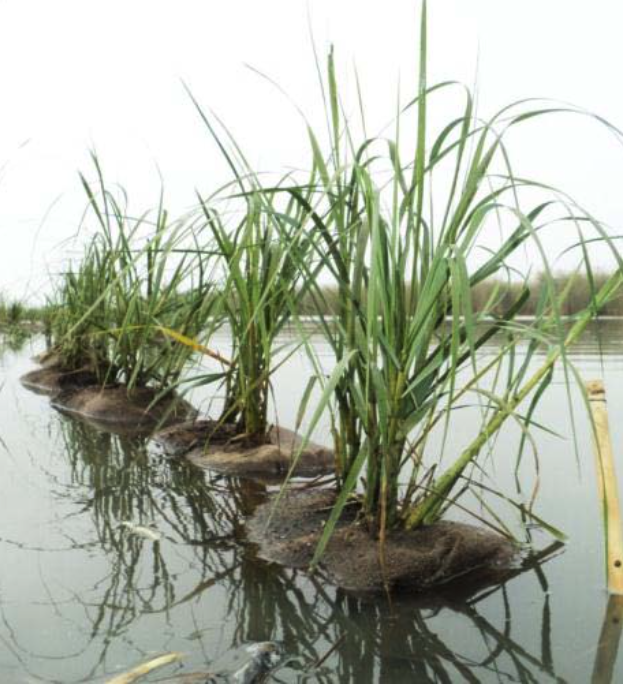 2000 SF of Bay-Saver Bags similar to the Gulf-Saver Bags™ pictured above were planted along the Maryland shoreline as a carbon offset for the Society of Environmental Toxicology and Chemistry (SETAC) annual meeting in 2013. Partners in the project include Matrix NewWorld, The Chesapeake Bay Environmental Center and Restore the Earth. Image: Restore the Earth
2000 SF of Bay-Saver Bags similar to the Gulf-Saver Bags™ pictured above were planted along the Maryland shoreline as a carbon offset for the Society of Environmental Toxicology and Chemistry (SETAC) annual meeting in 2013. Partners in the project include Matrix NewWorld, The Chesapeake Bay Environmental Center and Restore the Earth. Image: Restore the Earth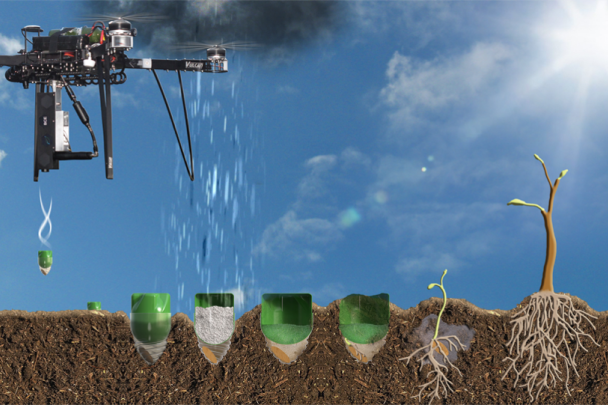 A fleet of drones could be used to plant a billion trees. Image:
A fleet of drones could be used to plant a billion trees. Image:  Hemp home under construction in Virginia Beach. Hempcrete walls exposed on the first floor have been sealed with a lime render on the second floor.
Hemp home under construction in Virginia Beach. Hempcrete walls exposed on the first floor have been sealed with a lime render on the second floor. 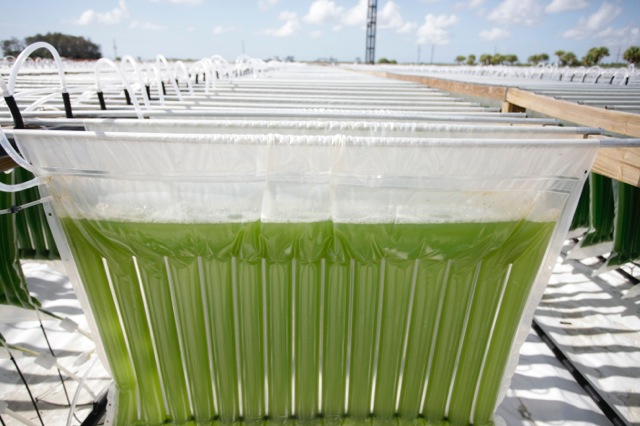 Algenol is producing a fuel from algae fed CO2 from 2 Florida power plants. While the captured CO2 is ultimately released, additional fossil emissions are avoided. Image:
Algenol is producing a fuel from algae fed CO2 from 2 Florida power plants. While the captured CO2 is ultimately released, additional fossil emissions are avoided. Image: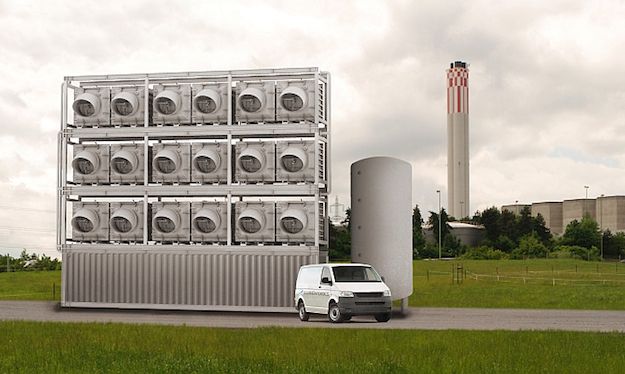 Ambient Air CO2 Capture Plant - Image:
Ambient Air CO2 Capture Plant - Image: